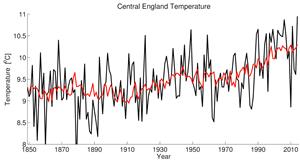Want to 'see' climate change? Check your thermometer
Release Date 05 October 2015

Scientists often use satellites, supercomputers or high-tech arrays of instruments to show how the climate is changing.
But now researchers at the University of Reading have shown how climate change can be visible, even at just one location, with the simplest instrument of all: a thermometer.
In research published today, the scientists say it is often difficult to decipher trends from an individual temperature record, due to the inherent variability of local weather. This means that many people struggle to ‘see' or ‘feel' climate change happening where they live, leading to a lack of understanding about its effects.
But if one takes a longer term view - looking at temperature records over many decades or more - then climate change can be easy to see, even on a local scale.
Professor Rowan Sutton, climate director at the National Centre for Atmospheric Science (NCAS) at the University of Reading, said: "When we talk about climate change, we often focus on the global average surface temperatures, but we know that most people and governments understandably care more about what's going on in their part of the world.
'Climate change is clearly visible, even in our own back yard' -- Prof Rowan Sutton
"For example, if we focus on a short record of just few years then temperatures in England and global temperatures aren't closely related. But if we look over the longer term, the agreement is remarkable. As the world has warmed, so England has warmed - climate change is clearly visible, even in our own back yard.
"Seeing how global warming is influencing each region of the planet, in one way or another, can be helpful in underlining how climate change is already having an impact on our lives - whether we recognise it or not.
"The evidence for global climate change as a result of human activity is settled. The latest research is now focussing on how those changes could affect individual countries or regions in the years ahead."
Dr Ed Hawkins, a co-author of the research, also from NCAS at the University of Reading, said: "Computer simulations and satellite data are important for understanding how the climate is changing, but sometimes the simplest sources of information, such as a humble thermometer, can provide the most compelling evidence."
The paper, ‘What does global mean temperature tell us about local climate?' by Rowan Sutton, Emma Suckling and Ed Hawkins, is published today (Monday 5 October 2015) in the journal Philosophical Transactions of the Royal Society A - the world's oldest scientific journal.
